A BRIEF HISTORY OF THE LAFAYETTE STUDIO
-
-
-
-
-
'...
the inspired pencil of Lafayette has limned for ages yet to come.'
-
James
Joyce, Ulysses, 1922.
| Lauder family group
- the wife, six sons and three of the four daughters of Edmund
Stanley Lauder (c 1828-1891) photographer and proprietor of Lauder
Brothers, Dublin. (Photograph from private collection. The sitters
are shown below, listed according to their (last known names.
|
A
larger version of the image to below can be loaded by clicking
on this text.
|
|
|
- Sarah Lauder
née Stack (c 1828-1913) wife of Edmund Stanley Lauder (top
centre)
- James Stack Lauder (James
Lafayette) (1853-1923) photographer and managing director
of Lafayette Ltd 1898-1923 (top left)
- George Marsh Lauder (George
Lafayette) (1858-1922) photographer and manager of Lafayette
Glasgow branch
- Edmund Stanley Lauder Jnr.
(1859-1895) photographer and property developer
- Robert Enraight Lauder (1861-1938)
medical officer of health
William Harding Lauder (1866-1918) photographer and co- managing
director of Lafayette Ltd 1898-1918 (left)
- Thomas Campion Lauder (1873-1943)
Lieut-Colonel RAMC (bottom centre)
- Lydia Harding Sproule née
Lauder (1857 - )
- Sarah Harding Hatte née Lauder
(1865 - )
- Harriet Barry formerly Hatte
née Lauder (1868-1933).
|
The Lafayette
studio has one of the oldest histories of any photographic business
in the world.
It was founded
in Dublin in 1880 by James Stack Lauder, who used the professional
name of James Lafayette. James was the eldest son of Edmund Lauder
, a pioneering and successful photographer who had opened a daguerreotype
studio in Dublin in 1853. In adopting the name 'Lafayette', James
created a new image for the family business, seeking to prosper from
the cachet of a French name: Paris was then the centre of the art
world and of avant-garde photography in particular.
James Lafayette
was 27 when he founded the new firm which, in its early days, was
variously known as 'Jacques Lafayette', 'J. Lafayette' and 'Lafayette'.
In fact, he was joined in the new venture by his three brothers, all
of whom were experienced photographers who had worked in their father's
three studios.
|
|
|
|
carte
backs from the original 'Lauder' studio
|
The new business
flourished from the start. It soon established itself as the premier
portrait studio in Ireland following commissions from the Viceroy
and leading members of the Irish aristocracy.
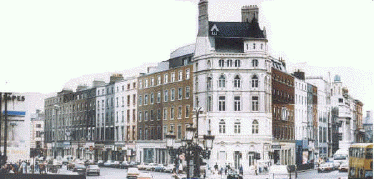
The
white building in the centre is the location of the main Lafayette
studio in Dublin
-
Almost
immediately James Lafayette started to attract favourable
reviews in newspapers and photographic journals. He also
began to win exhibition medals
for his portraits of society beauties, actresses and children
not only in Ireland, but England, France and America.
In 1884 he was elected a member of the Photographic Society
of Great Britain. By 1885 the firm was registering some
of its best work for copyright, and had attracted the
attention of the Royal family with its best-selling portraits
of Princess Alexandra, taken to mark the Royal visit to
Ireland of that year.
In
1887 James Lafayette was invited to Windsor to photograph
Queen Victoria and was granted a Royal Warrant as 'Her
Majesty's Photographer in Dublin'. This Royal Warrant,
which was subsequently renewed by King Edward VII and
George V, conferred enormous prestige. The style and title
of 'Photographer Royal', which now appeared on the studio
advertising and promotional literature, proved extremely
useful in attracting new clients.

-
-

-
-
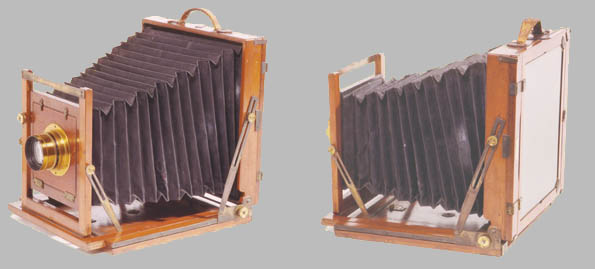
-
-
Studio
camera of the type used by Lafayette
-
[back
view shows glass plate negative in place]
The
Lafayette business expanded rapidly in the 1890s. Studios were
established in Glasgow (1890), Manchester (1892)(see line drawing
below), and with the surge of business in Jubilee year (1897)
a branch was opened on London's Bond Street. a
branch was opened on London's Bond Street. Subsequently
another studio was established in Belfast (1900).
-
|
|
| The
Bond Street, London, Studio - click image for more
details |
- In 1898 all the
Lauder family businesses were incorporated and shares in the
newly established Lafayette Ltd. were floated on the Stock
Exchange. By this point James Lafayette had left the Dublin
studio in the hands of his brother, William Harding Lauder,
and was managing the London studio. Following his commission
to photograph guests at the Duchess
of Devonshire's costume ball in 1897, James Lafayette
was clearly established as the most commercially successful
portrait photographer of the day. London was then the centre
of the world stage and the Bond Street studio photographed
the most prominent people at court, in society, the arts,
the armed forces, and the professions, as well as a stream
of foreign visitors, from Japanese diplomats to African princes.
In 1898 James Lafayette was even recommended for a knighthood
in the pages of The Photogaphic News. (This honour
for photography, in fact, had to wait until 1972 with the
knighthood of Cecil Beaton.)
|
|
|
|
|
|
The
Deansgate, Manchester Studio
|
-
The
prosperity of the Lafayette business in the 1890s and
early twentieth century was closely linked to the expansion
of the press. Many Lafayette photographs were published
in the national and provincial newspapers, as well as
in the many new photographically illustrated magazines
made possible by advances in printing technology. As early
as 1893, for example, Lafayette's wedding photographs
of the Duke and Duchess of York at Buckingham Palace were
published in The Illustrated London News and
The Gentlewoman.
-
In some cases Lafayette
seems to have made special arrangements to supply large numbers
of photographs to new magazines. Country Life, for
example, was founded in 1897. During its first year, Lafayette
provided more than 30 of the magazine's 52 weekly frontispiece
portraits. The Scots Pictorial, which was also established
that year, was supported by the Glasgow studio.
 |
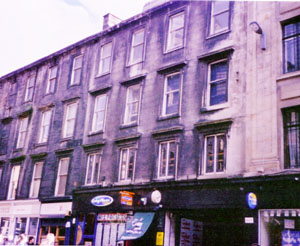 |
Gordon
Street, Glasgow - approximate site of the studio |
Such was the volume
of press work that from 1914 to 1927 there was a special office
in Fleet Street to deal with it.

James Lafayette
died in Bruges in 1923, at the age of 70. He was by far the
most dynamic, entrepreneurial member of his family and, following
his death, the company went into relative decline. A new generation
of photographers, including Bertram Park, Hugh Cecil, Paul
Tanqueray, and Dorothy Wilding, was providing competition
to established commercial photographic studios such as Lafayette.
The Stock Market crash in 1929 and the ensuing Great Depression
also had a devastating effect: Lafayette operated at a loss
for most of the 1930s.

A
cameo of Daisy, Countess of Warwick
from a Lafayette publicity brochure
'Lafayette
Ltd.' continued to function until 1952, although the business
was not finally wound up until 1962. The Lauder family and
its employees were thus producing photographs continuously
from 1853 until 1952. They also kept a library of their most
important negatives, almost all of which were marked with
the name of the sitter and the date when the negative was
made.
|
|
|
|
The back of a Lafayette
carte 1897
|
|
|
|
|
|
the
opening and back page of a Lafayette publicity brochure
circa 1902
|
|

Handwritten
note enclosed with a publicity brochure circa 1902
The Dublin branch
of the business, which was sold off in 1951, still survives.
Until the 1990s it was run by the oldest photographer in Ireland,
a former employee and nephew of Walter Pannell, a photographer
who worked with James Lafayette. Some of the 19th-century props
and photographic equipment are still in use to this day.
Sadly,
the majority of negatives from the Dublin studio were destroyed
in 1951 (allegedly sold for re-use as glass panelling for green-houses).
Several hundred historic glass and nitrate negatives survive,
however, including early examples of royal photo-journalism
and portraits of famous Irishmen such as Patrick Pearse, leader
of the Easter Rising, George Bernard Shaw and W.B. Yeats.

Some
very important negatives from the London studio and a smaller
number from the provincial English branches survived in a London
attic. In 1972 they were moved by builders to Pinewood Studios,
where in 1988 they were rediscovered in a props store and given
to the V&A (see Sunday Times
article). The Museum decided to keep the 3,500 glass plate and
celluloid negatives dating from 1885 to c. 1937, but transferred
the rest of the collection, consisting of 30,000 - 40,000 nitrate
negatives from the 1920s to the early 1950s, to the National
Portrait Gallery.
In addition
to these two large archives of negatives, the Earl of Haddington
holds a substantial number of uncatalogued negatives, mostly
on film, at Mellerstain, his home in Berwickshire.

There
are, of course, a vast number of prints of Lafayette photographs
still in existence. Large collections of Lafayette photographs
can be found in the Royal Archives, the main commercial picture
libraries and the Gernsheim Collection at the University of
Texas. There are also several smaller specialist collections.
Most negatives in the V&A and NPG collections can thus be
matched with surviving photographs in period frames and family
albums, photographs published in newspapers and magazines, postcards,
and prints sold for mass circulation.

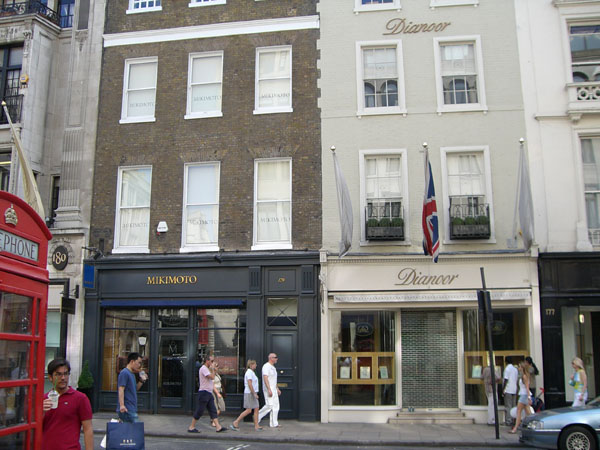
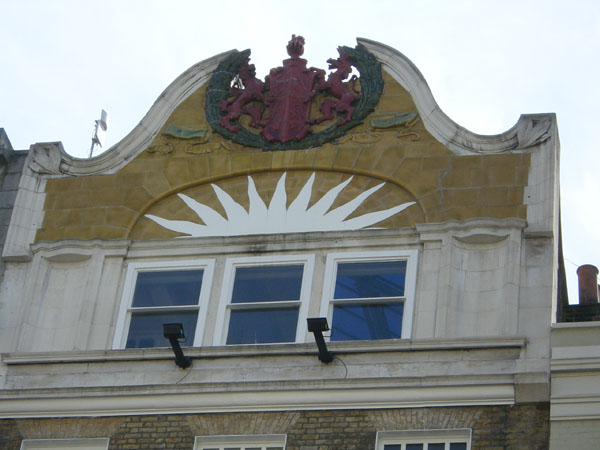
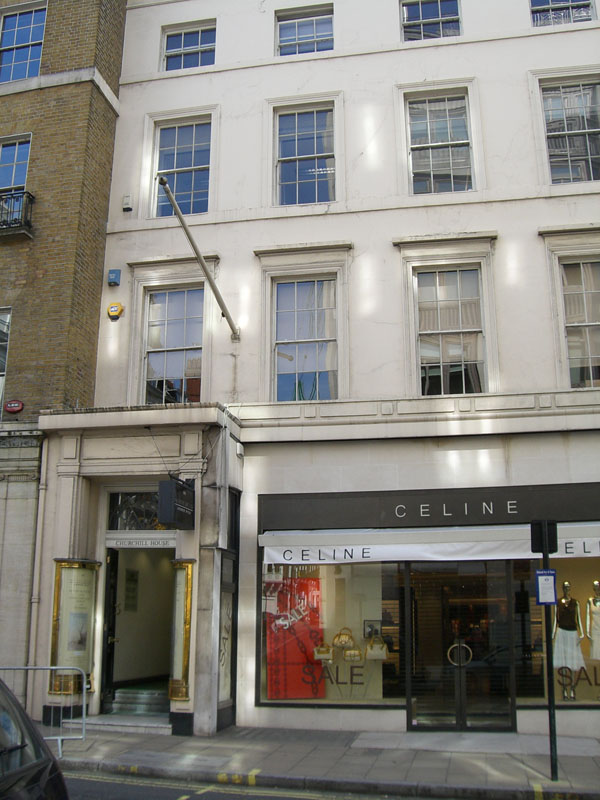

1939 Customer Proof
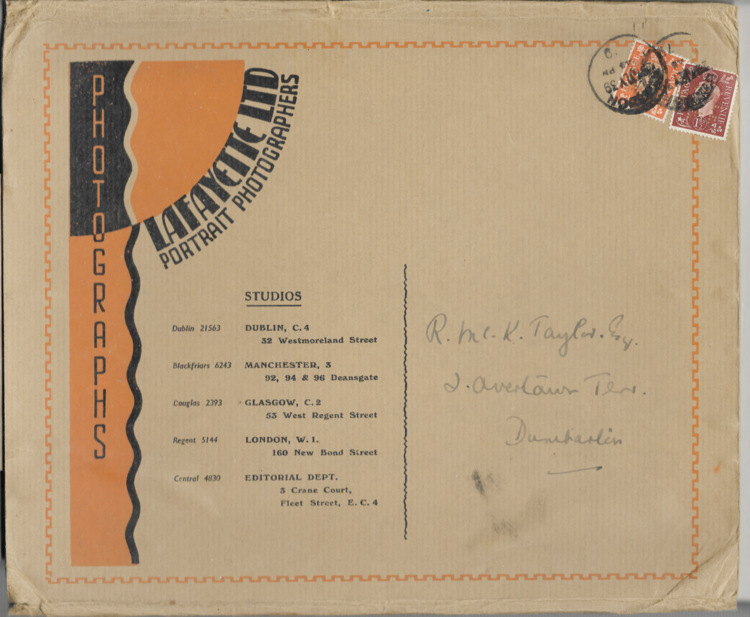
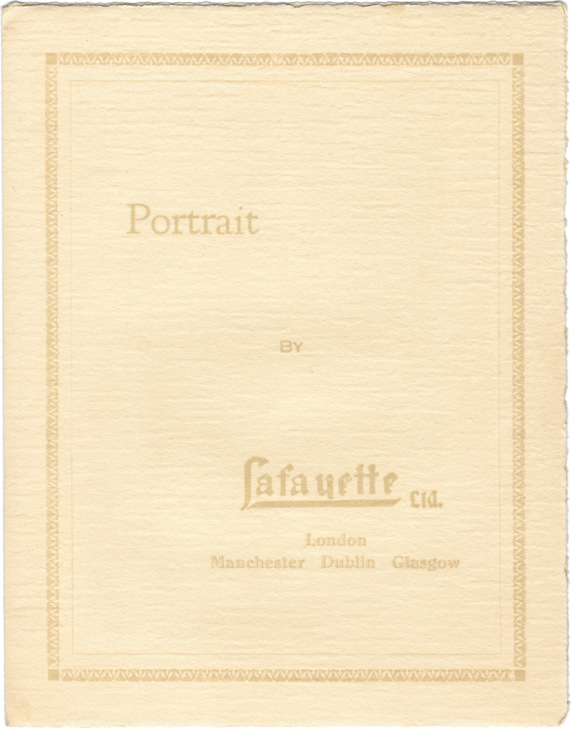

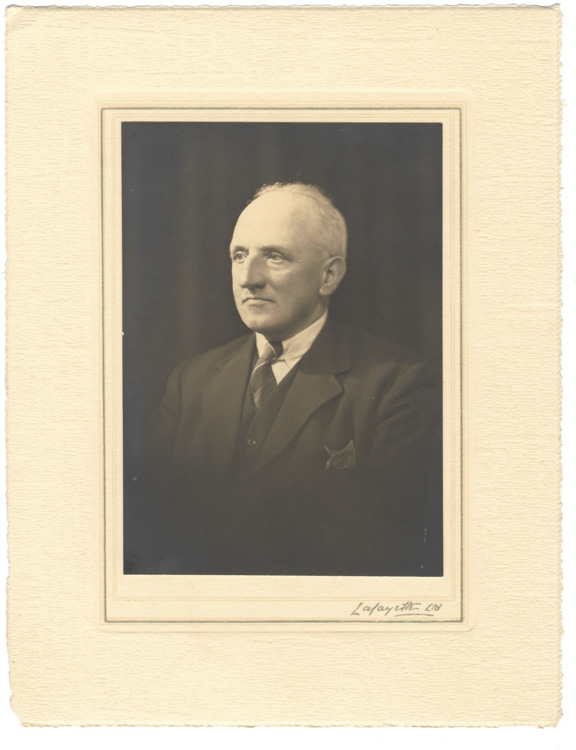
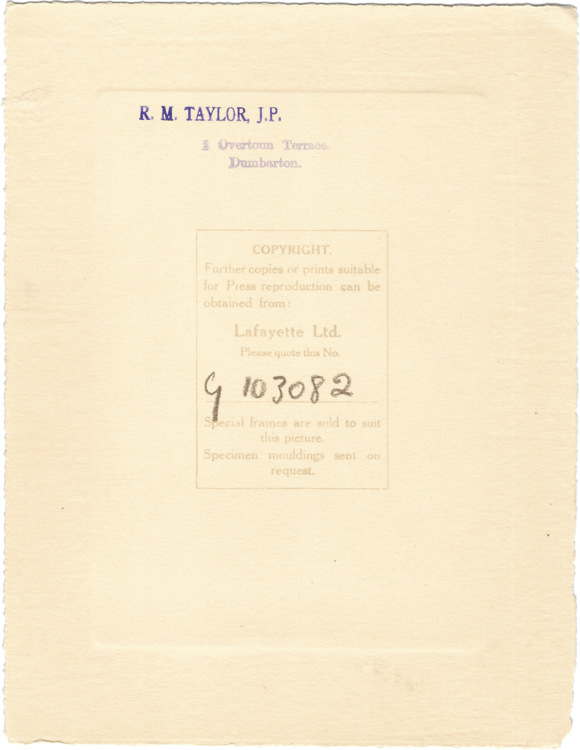
|
-
-
|
|